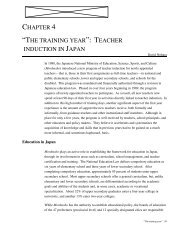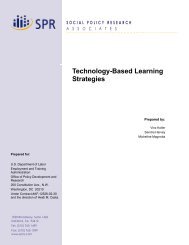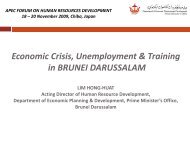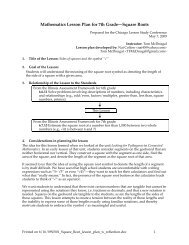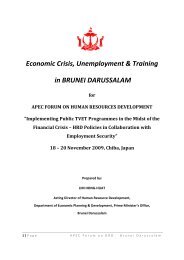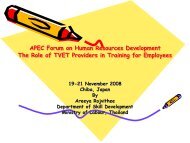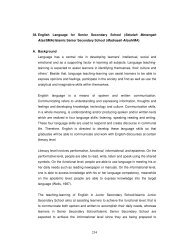Quality Assurance Systems in Asia-Pacific Economic Cooperation
Quality Assurance Systems in Asia-Pacific Economic Cooperation
Quality Assurance Systems in Asia-Pacific Economic Cooperation
Create successful ePaper yourself
Turn your PDF publications into a flip-book with our unique Google optimized e-Paper software.
ENHANCEMENT OF QUALITY ASSURANCE SYSTEMS IN HIGHER EDUCATION IN APEC MEMBER ECONOMIES<br />
outcome. Follow<strong>in</strong>g that, the HEI submits the application (some agencies charge a fee), which<br />
sets out the grounds for the appeal aga<strong>in</strong>st the quality assurance outcome. There are wide<br />
variations <strong>in</strong> the composition of the body/committee that deals with the appeals and the<br />
powers of the committee.<br />
Some QA systems have stand<strong>in</strong>g committees that act as appellate authorities and <strong>in</strong> some<br />
cases the govern<strong>in</strong>g body of the QA agency acts as the appellate authority. A few others do<br />
not have a designated appellate authority and the executive head of the QA body itself might<br />
review the appeals. In some cases the QA agency or its govern<strong>in</strong>g board sets up ad hoc sub<br />
committees case by case. But <strong>in</strong> all cases, the appeals committee is expected to function<br />
<strong>in</strong>dependently and provide fair judgement about the appeal.<br />
The power vested <strong>in</strong> the appeals committee and the action that can be taken after the<br />
appeals committee’s decision varies among agencies. It varies from the appeals committee<br />
mak<strong>in</strong>g f<strong>in</strong>al decisions on the appeal to giv<strong>in</strong>g recommendations and impressions to the<br />
quality assurance agency for its consideration. Some agencies specifically provide for an<br />
appeal to the court of law, as <strong>in</strong> the case of NAA. INQAAHE Guidel<strong>in</strong>es for Good Practice<br />
recommends that depend<strong>in</strong>g on the context <strong>in</strong> which the QA body operates, it has to evolve<br />
an appropriate appeals mechanism right <strong>in</strong> the beg<strong>in</strong>n<strong>in</strong>g and make it known to all those<br />
<strong>in</strong>volved <strong>in</strong> the process. However, this rema<strong>in</strong>s an area that needs further attention.<br />
6.6 Follow-up<br />
After the disclosure of the quality assurance outcome, it is expected that the <strong>in</strong>stitution will<br />
take whatever actions are necessary <strong>in</strong> relation to the recommendations or issues noted <strong>in</strong><br />
the review. While fund<strong>in</strong>g l<strong>in</strong>ks, <strong>in</strong>centives and sanctions may be a motivat<strong>in</strong>g factor for many<br />
HEIs to act on the review outcomes, <strong>in</strong> most systems it is ma<strong>in</strong>ly the professional commitment<br />
of the HEIs that leads to actions and improvement.<br />
BAN-PT, NIAD-UE, NAA, SPRING and KCUE do not have any specific follow-up<br />
mechanisms. The responsibility and formal role of the quality assurance agency ends with the<br />
review. The <strong>in</strong>stitutions are responsible for the plann<strong>in</strong>g and implementation of follow-up<br />
measures. Depend<strong>in</strong>g on the nature of the recommendations, m<strong>in</strong>istries of education or other<br />
stakeholders may react on the review.<br />
<strong>Quality</strong> assurance agencies have built-<strong>in</strong> follow-up procedures with vary<strong>in</strong>g levels of rigour.<br />
Some require b<strong>in</strong>d<strong>in</strong>g actions to be taken by the HEIs and <strong>in</strong> other cases it may be a “soft<br />
touch” based on the professional commitment that can be expected of the HEIs. In Thailand,<br />
Office of Higher Education Committee and M<strong>in</strong>ister of Education monitor the action taken on<br />
the report of ONESQA <strong>in</strong>clud<strong>in</strong>g the timeframe. ITP-Q requires <strong>in</strong>stitutions to act on the report<br />
with<strong>in</strong> 3 months or accord<strong>in</strong>g to the agreed timel<strong>in</strong>e for corrective actions. NZQA requires<br />
<strong>in</strong>stitutions to provide an Action Plan and if this is not carried out satisfactorily with<strong>in</strong> the<br />
timeframe, legislation allows for compliance action. NZUAAU requires the Panel Chair and<br />
the Director of NZUAAU to visit the HEI, 3 months after publication of the report. Dur<strong>in</strong>g that<br />
visit, a timetable for a follow-up report is decided. AACCUP does the follow-up through the<br />
agency staff. If monitor<strong>in</strong>g is needed, PAASCU asks for a progress report after 2–3 years and<br />
arranges an <strong>in</strong>terim visit.<br />
Yet another approach is to l<strong>in</strong>k the follow-up to the subsequent reviews. In this approach,<br />
follow-up is the responsibility of the <strong>in</strong>stitution, but QA decisions are valid for a specific<br />
duration and follow-up is a strong consideration at the next review. This option l<strong>in</strong>ks the<br />
quality assurance cycles <strong>in</strong> various ways. The agency may choose to check on earlier<br />
recommendations and base its subsequent QA decisions on how the <strong>in</strong>stitution or program<br />
has acted on those recommendations. In Australia, AUQA follows this approach and<br />
proposes to build the subsequent audits on the outcome of the previous audits where<br />
<strong>in</strong>stitutions will have to substantiate how they have acted on the audit outcomes. The HEIs<br />
audited by AUQA are required to make public “a progress report” approximately 18 months<br />
after the publication of the audit report and this progress report will become one of the key<br />
<strong>in</strong>puts for the subsequent audits. CNAP follows a similar approach.<br />
26



